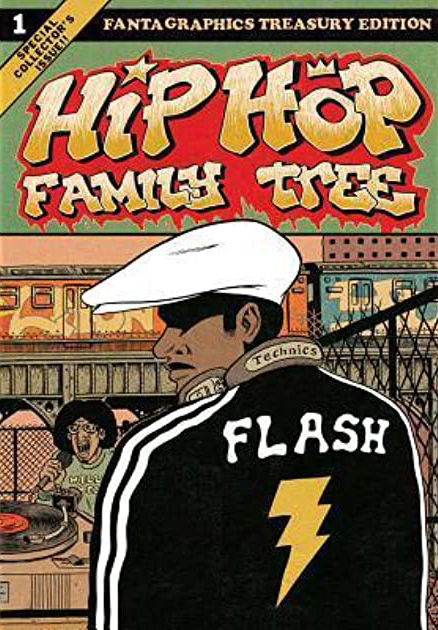Hip Hop Family Tree Vol. 1 by Ed Piskor

This New York Times all-time-selling series (completed in 2013) won the hearts and minds of American graphic novel critics. When NPR listed "Hip Hop Family Tree" in their 100 favourite graphic novels (of all genres) they reflected upon what reviewer Etelka Lehoczky said about writer and illustrator Ed Piskor'southward work on how he "uses every play tricks in the comic-book playbook to keep things taut and crackling.
He varies figures' sizes, adds and subtracts different gradations of colour and moves from realism to cartoony exaggeration." NPR went even further saying "It's a long-form history lesson that'southward infectiously fun — 1 that should be taught in schools." With seldom reviews outside of the U.s.; XS Noize will mensurate Piskor'south work in its ability to captivate an international audience.
Piskor takes pride in both hip hop and comics and is proud to say that they are both American (New York Specifically) inventions. Similarly, XS Noize has fatigued parallels equally to how music and comics complement each and make each other better by working in unison. The story of hip hop is for the well-nigh function a story of New York, more than specifically the Bronx civic. Whilst overall chronological; Piskor does non festoon the 114 pages with dates, instead, he focuses on the pivotal moments/events and players which led to hip hop existence noticed past the mainstream media in 1981.
The first breakthrough according to Ed is when DJ Kool Herc coined the term "Merry-Become-Circular" where one mixes one break into the break of another vocal. "Scratching" was accidentally invented by Grandmaster Flash's protégé Grand Wizzard Theodore. The concert venues where hip hops MC's and DJ's including DJ Disco Wiz and Casanova Fly, DJ Baron and K.One thousand. Rockwell found acclaim were the humble Bronx basketball courts, gyms and parks. Some other element critical to DJ crews winning audiences was investing in equipment such as the "Clubman Two" mixer which DJ Hollywood was one of the beginning to possess.
A cardinal strength of "Hip Hop Family unit Tree" is that Ed Piskor looks beyond the legendary status afforded to figures such as Grandmaster Flash who was initially so "preoccupied with mixing and scratching that "he did non always know what to say on the mic". This situation just changed when he teamed upwards with Cowboy. Piskor besides informs the reader that in that location was another before Volition Smith'due south collaborator DJ Jazzy Jeff. The original Jazzy Jeff was recruited by K.Grand. Rockwell who Rockwell went to school with. Ed also introduces the reader to certain slang terms such every bit the "Alps" which doesn't refer to Swiss ski slopes.
The primary figure of hip hop graffiti art Fred from "The Fabled Five" afterwards to become "Fred Fab Five" (who would become acquainted with artist Jean-Michel Basquiat and get friends with Blondie's Debbie Harry and Chris Stein) has the nigh interesting pre-history.
Fred's grandad was friends with Marcus Garvey and Fred's parents frequently entertained famous jazz musicians including Dizzy Gillespie and Miles Davis at their Bedford Stuyvesant Home. The necessity and urgency that this book should exist taught in schools are merely too profound when Piskor reveals that the outset African- American to offset a business following Globe State of war Two in America was Bobby Robinson who opened a record shop on 125th Street which is located near. The Apollo Theatre would help the likes of DJ Hollywood progress in their careers.
Through Piskor, ane can follow the story of the growing importance of hip hop culture through several events: the release of bootleg copies of essential "important suspension songs" by artists including Bob James and New Birth; radio play of King Tim 3'S B-side "Fatback" on the radio and "Rappers Delight" past Sugar Hill Gang constantly selling out at record stores. The fact that rappers from outside New York including Connecticut'southward Mr Magic and music publications including Tom Silverman's "Dance Music Study" began covering hip-hop releases (including the independently produced "Big Apple Rappin" by Spyder D who sold 10,000 copies) were also poignant breakthrough moments. With hip hop artists getting mainstream attention opportunities arrived for the like of Grandmaster Flash to open up for artists similar The Clash at the Bonds International Casino in New York.
Lehoczky is more correct in maxim how deft Piskor'south illustrations are. The tea-stained pages offering a retro bootleg feel. The anaglyph 3D effects on some of Piskor's sketches are highly adroit. Likewise as list all the pioneers of this flow up till 1981; Piskor also lists their forbears who influenced them. Piskor is correct non to also include real names along with stage names as this would accept been far too overwhelming and the bulk of readers would lose their train of thought. Upon reading "Hip Hop Family Tree", one will realise how picayune they really know about hip hop music, artists and culture. "Hip Hop Family Tree" is truly a divine inspiration for all (not just the USA) revealed via the prophet Ed Piskor who is also known for his piece of work on "X-Men: Grand Design".
Source: https://www.xsnoize.com/book-review-hip-hop-family-tree-book-1-1970s-1981-by-ed-piskor/
0 Response to "Hip Hop Family Tree Vol. 1 by Ed Piskor"
Post a Comment